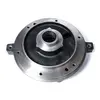Mobile:+86-311-808-126-83
Email:info@ydcastings.com
rotating impeller
The Impact of Rotating Impellers on Fluid Dynamics
Rotating impellers are crucial components in a variety of mechanical systems, particularly in pump and mixing technologies. Their design and operation significantly influence fluid dynamics, directly impacting efficiency, performance, and application versatility. This article explores the mechanics of rotating impellers, their applications, advantages, and considerations in engineering design.
An impeller is typically composed of a series of blades or vanes mounted on a rotating hub, which can be either axial or radial in design. The fundamental principle behind impeller operation is the conversion of rotational energy from a motor into kinetic energy of the fluid. As the impeller spins, it generates a pressure difference that draws fluid into the center and expels it outward, resulting in flow.
The mathematical depiction of fluid flow generated by an impeller can often be represented through computational fluid dynamics (CFD) simulations. These simulations allow engineers to visualize and analyze how fluid moves in relation to the impeller's rotation, estimating factors like velocity profiles, turbulence intensity, and pressure distribution. Such insights are critical in optimizing impeller design for various industrial applications.
One primary application of rotating impellers is in centrifugal pumps. These devices utilize the high-speed rotation of the impeller to increase the energy of the fluid, resulting in efficient movement from one location to another. The performance of centrifugal pumps is heavily reliant on the impeller's design, including factors such as blade geometry, diameter, and material. For instance, a larger impeller can generate higher flow rates but may result in increased energy consumption, necessitating a balance between flow requirements and efficiency.
Mixing processes also heavily rely on the principles of rotating impellers. In chemical manufacturing, the proper mixing of reactants is essential for creating a homogeneous product. Here, impellers are designed to create specific flow patterns that enhance mixing efficiency. For example, an axial flow impeller is used when a gentle mixing action is required, while a radial impeller might be selected for applications needing higher shear forces.
rotating impeller

Beyond conventional liquids, rotating impellers are also utilized in the field of wastewater treatment, where they assist in aerating and mixing waste streams. This process is vital for facilitating aerobic digestion, where microorganisms break down organic matter. Effective mixing ensures that the microorganisms remain evenly distributed throughout the liquid, optimizing their growth and nutrient uptake.
Another significant advantage of impellers is their role in enhancing heat transfer, particularly in cooling and heating applications. By promoting turbulent flow, impellers can significantly increase the rate of heat exchange between fluids, making them essential in heat exchangers and cooling systems. A well-designed impeller can reduce energy consumption while improving the overall thermal performance of the system.
Despite their numerous advantages, the design and operation of rotating impellers are not without challenges. Cavitation is a common issue in centrifugal pumps that can severely damage impeller blades. This phenomenon occurs when the pressure of the fluid drops below its vapor pressure, causing vapor bubbles to form and subsequently implode when they enter higher-pressure areas. Engineers must account for this phenomenon during the design phase by selecting appropriate materials and creating geometries that minimize cavitation risks.
Furthermore, the efficiency of an impeller is often evaluated through performance curves that illustrate the relationship between flow rate, head, and power consumption. Understanding these curves helps engineers select the correct impeller for specific applications and ensures that systems operate within optimal ranges.
In conclusion, rotating impellers are indispensable elements in the field of fluid dynamics, influencing a variety of applications from pumps to mixers and heat exchangers. Their ability to convert mechanical energy into effective fluid movement makes them pivotal in industries such as chemical processing, wastewater treatment, and HVAC systems. Continuous advancements in design and engineering, fueled by computational modeling and research, promise to enhance the performance and efficiency of rotating impellers, paving the way for innovative applications in the future. As technology progresses, the role of rotating impellers will undoubtedly expand, underscoring their importance in modern fluid management systems.
-
Impeller Technology That Powers Precision in Pump SystemsNewsMay.22,2025
-
Valve Durability Begins with Quality Cast Iron ComponentsNewsMay.22,2025
-
Performance Cooling with Advanced Automobile Water Pump SolutionsNewsMay.22,2025
-
How Motor Housing and Oil Pans Shape Engine PerformanceNewsMay.22,2025
-
How Metal Castings Drive Modern Manufacturing EfficiencyNewsMay.22,2025
-
Exploring the Engineering Behind Valve Body CastingsNewsMay.22,2025











